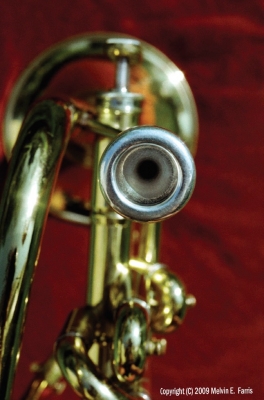Performing in an Orchestra
A Trumpet Player's Viewpoint
I am fortunate that I have the opportunity, as an amateur musician, to play a wide variety of music, from jazz and classical, to pop and folk. Hopefully, I also understand the various styles of music that I play and perform. Among others I play in a symphony orchestra. As an orchestral trumpeter, technically, certain music, especially from the Romantic period, is generally not all that difficult to play. With some effort and concentration, I am usually able to work through the material.
But it takes a lot more serious effort to understand what the composer is trying to say. All composers, except perhaps for the most trivial or inept ones, are telling us something. But alas, music is a very abstract art form. Listening to a performance, or even performing, is a very frustrating experience. The note or phrase is gone before you can even comprehend what has happened. Music is not like the plastic arts, or a book. In other art forms you can linger over the picture or statue and come back to it again. You can find commentaries and then return to the object. In a book you have the opportunity to read and reread the sentence, phrase, or paragraph several times, both in and out of context and then perhaps gain a fuller meaning. Not so in music.
Going to a concert or even performing in one is like chasing after a rainbow, the music is always just beyond reach. But, listening to music as the great composer Aaron Copland wrote in the preface to his important book What to Listen for in Music, (Mentor Books published by Penguin Group, 1985), "To a composer, listening to music is a perfectly natural and simple process." Well, Copland also asks, is it so simple? He goes on to propose that a composer would like to know two things from his audience (a performer is also an audience/interpreter to the composer): 1. Are you hearing everything that is going on? Or are you missing something; 2. Are you being sensitive to it (the music)? That is, are you, the listener confused or is your emotional response clear?
It is almost impossible to understand music by reading about it. To even begin understanding music it is necessary to listen to music and to listen to a lot of music of a large variety. But, listening to music is also a complex act. Listening to a pop song sung with very little accompaniment is a lot different than listening to a full-blown symphony by Beethoven, Brahms, Mahler, or Copland, performed by an orchestra with sometimes 100 musicians. These are different levels of complexity, neither necessarily better nor worse, just distinctive.
In the orchestra that I play in we have performed Beethoven's Symphony No. 2 in D Major, Op. 36. This is a wonderful and exciting jewel of music. But, this is still early Beethoven and highly reminiscent of Haydn and Mozart. Beethoven's 3rd Symphony, which explosively breaks out of the Haydn frame, was not yet written. Throughout the 2nd Symphony things are very clear and generally expected. But there are moments in the 2nd where Beethoven starts to break away from what was then the traditional approach to write a symphony. His third movement, called "Scherzo," or "joke" in Italian, did away with the traditional minuet. The use of the term "scherzo" seems to be something original with Beethoven and used extensively by many composers thereafter. This Scherzo is a fast-paced movement full of life and light-hearted fun. But, as usual with Beethoven in the 2nd Symphony, his marked instructions are surprisingly precise, and the instrumentalists must follow his clear, but sometimes difficult directions - open to the conductor's interpretation. Beethoven is speaking to us over a long period of time. The music is exciting, shining, bright, and a delight to the ear. Listening to Beethoven, no matter what, is an ever unfolding wonderful musical and emotional experience.
Playing trumpet in this piece is almost like being a percussionist. The trumpets frequently play the same or similar rhythms that the timpani beat out, although there are a number of fanfare type motifs that the pair of trumpets must execute to bring out brilliance. Due to the nature of trumpets and trumpet players during the time of Beethoven, the two trumpets play either in unison or the same note, but in different octaves.
So, the next time that you go to a concert, listen to the trumpets, especially in music from the Romantic period. Watch and listen to how the trumpet players struggle to blend in with the orchestra and yet add the necessary brilliance to the music. The trumpets add life and vigor to the strings who are "sawing" away en mass. And in Beethoven's Symphony No. 2 the entire piece speaks in a vigorous voice full of life and joy.








Comments